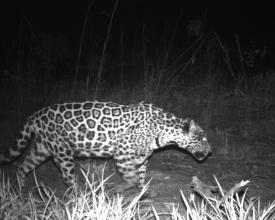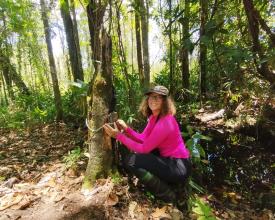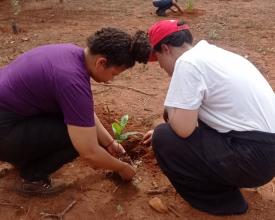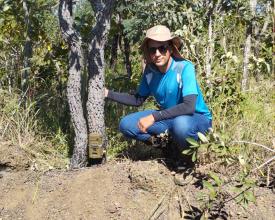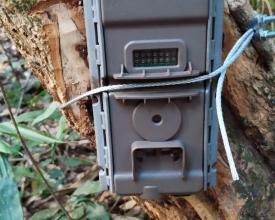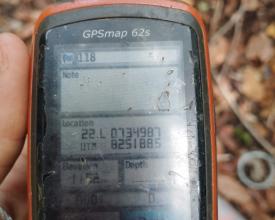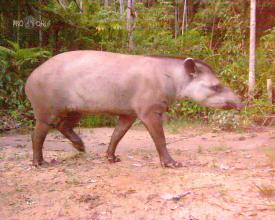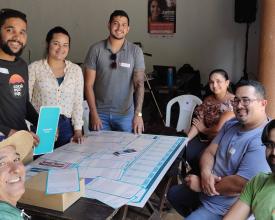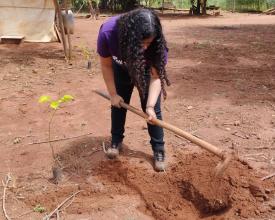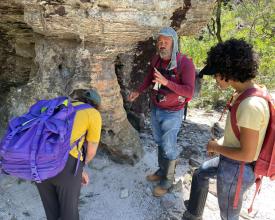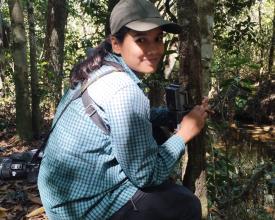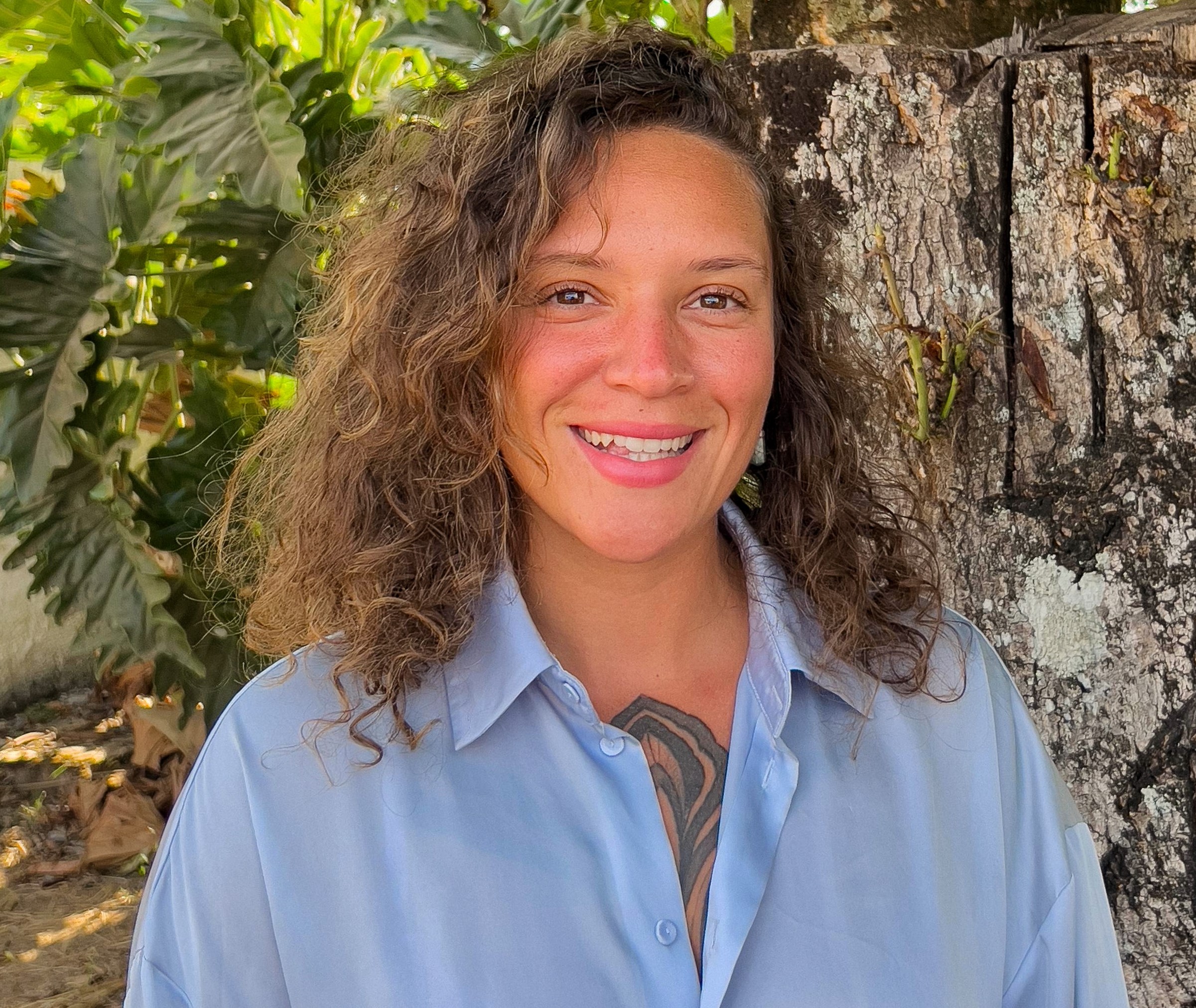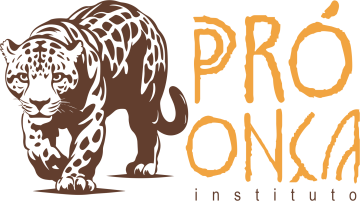
Women's leadership in jaguar conservation
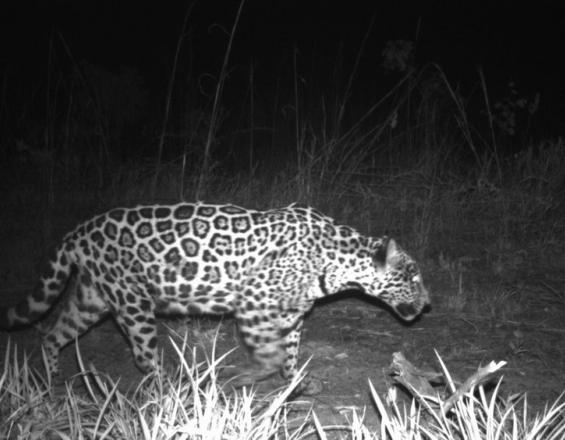
Since 2023, the Pró-Onça Institute has led a community-driven initiative in Brazil’s southern Cerrado to mitigate human-jaguar conflict and enhance climate resilience. We empower rural women as leaders in habitat restoration and wildlife monitoring, using drones, satellite data, camera traps, and geospatial tools to track jaguar movements across 70,000 hectares. Real-time data informs coexistence strategies between jaguars and ranchers. The solution supports the Kunming-Montreal Global Biodiversity Framework: Target 3 (conservation), Target 4 (restoration), and Target 21 (participation). It combines technological innovation with community leadership, yielding measurable outcomes: increased female participation, reduced conflict, and improved ecosystem resilience. Local conservation committees and ecotourism initiatives promote long-term sustainability, while responsible e-waste management ensures environmental integrity.
Context
Challenges addressed
Environmentally, the region faces erratic rainfall, prolonged drought, and rising temperatures, driving land degradation and biodiversity loss. We integrate drones and satellite data to monitor jaguar movements and guide habitat restoration through wildlife corridors, enhancing ecosystem resilience to climate change.
Socially, climate impacts increase human-jaguar conflict. By empowering marginalized rural women as conservation leaders, we reduce gender inequalities and foster community-led coexistence strategies. Workshops led by trained women strengthen local technical capacity for monitoring and conflict mitigation.
Economically, rural communities face limited funding and lack alternative income. Our initiative promotes sustainable livelihoods, particularly eco-tourism, diversifying household income, reducing dependency on livestock, and supporting long-term conservation. These actions build resilience and environmental stewardship.
Location
Process
Summary of the process
Community-based conservation training establishes the foundation for local capacity development, equipping communities with skills for restoration and effective conservation engagement. This training directly complements technology-enhanced wildlife monitoring, enabling trained community members to apply technical tools for collecting vital ecological data and reinforcing their environmental stewardship.
The data generated informs collaborative land management planning, ensuring that strategies align with community needs, ecological dynamics, and conflict mitigation priorities. Simultaneously, ecotourism development transforms conservation engagement into sustainable livelihoods, creating a feedback loop where revenue supports further training, restoration, and monitoring efforts.
Finally, integrating gender perspectives ensures inclusivity, amplifying diverse community voices and leadership, particularly of women, across all components. Together, these interconnected elements build a resilient, participatory conservation framework that promotes ecological integrity, social equity, and long-term sustainability.
Building Blocks
Community-based conservation training
This building block emphasizes the development and implementation of comprehensive training programs tailored for local communities, focusing on wildlife conservation strategies, habitat preservation, and effective conflict mitigation techniques essential for both community and ecological health. The program includes multiple modules on key aspects of conservation, such as jaguar behavior, the ecological role of apex predators, and identification of habitats and corridors that facilitate safe wildlife movement.
Participants also receive practical training on sustainable agricultural practices that minimize habitat encroachment and livestock predation. For example, integrating agroforestry techniques helps create buffer zones by planting shade trees alongside cash crops, thus promoting biodiversity and offering alternative livelihoods for local farmers. The program also addresses non-lethal conflict resolution techniques, such as employing guard animals and installing protective fencing, while launching community awareness campaigns that promote coexistence.
This training model is transferable to other regions facing similar human-wildlife conflicts, offering a scalable approach to community-based conservation and long-term ecological resilience.
Enabling factors
Successful implementation of these training programs requires a collaborative approach, including partnerships with local entities specializing in conservation education, governmental agencies for capacity-building initiatives, and research institutions that support monitoring efforts and validate community-generated data. These collaborations facilitate resource sharing and expertise, creating a robust support network that enables local communities to translate training into action.
Access to tailored educational materials, such as manuals on local ecosystems, wildlife behavior, and community case studies, plays a critical role in fostering an informed populace ready to take action. It is also crucial to integrate traditional ecological knowledge with contemporary conservation practices. Engaging local elders and traditional leaders ensures that training resonates with community values, enhancing cultural acceptance and ownership among participants, transforming them into advocates for sustainable practices and wildlife protection.
Lesson learned
The experience gained through these training initiatives clearly demonstrates that programs weaving local cultural practices and traditional ecological knowledge into their frameworks yield significantly greater community engagement and commitment to conservation goals. For example, using storytelling of local folklore related to jaguars fosters a personal bond between community members and the species, instilling a sense of responsibility for its protection.
Furthermore, implementing gender-specific training is pivotal for empowering women to assume leadership roles in conservation efforts. By actively engaging women, these programs deepen community buy-in for wildlife management practices and result in more inclusive decision-making processes.
We learned that community-based conservation training serves as a pathway to building resilient communities that prioritize and protect their natural heritage while fostering sustainable livelihoods. Sustained engagement and periodic reinforcement of these training programs are essential to maintain motivation, update skills, and ensure long-term conservation success.
Technology-enhanced wildlife monitoring
This building block emphasizes the transformative role of technology in monitoring wildlife populations and habitats, particularly jaguars. As apex predators, jaguars are key indicators of ecosystem health; understanding their movements and habitat use is vital for effective conservation. Using tools like camera traps, drones, and remote sensing, we collect high-resolution data on jaguar behaviors and habitat changes. Strategically positioned camera traps provide real-time insights into movements, breeding, and conflicts, supporting adaptive management and rapid responses.
Combined with satellite imagery, these technologies offer a holistic view of habitat conditions, tracking land use changes, vegetation cover, and threats such as poaching. Data are transmitted via mobile and satellite networks to a centralized platform, enabling timely analysis and coordinated conservation actions. The program incorporates citizen science by training local community members in data collection and reporting, fostering ownership and enhancing local capacity. E-waste generated by equipment is responsibly managed through certified recycling. This participatory, tech-driven approach strengthens conservation outcomes and long-term sustainability.
Enabling factors
Access to reliable technology and sustainable funding—for equipment such as camera traps, drones, and laptops—is essential. Financial support can come from government grants, NGOs, and private-sector partnerships. Collaborations with academic institutions and technology firms are critical for delivering training in data collection, analysis, and tool operation. Engaging local universities fosters research opportunities and strengthens the knowledge base on jaguar conservation.
Strong partnerships with wildlife authorities ensure that data informs local management strategies, while clear protocols for data sharing safeguard ethical use. Responsible management of electronic waste, through recycling programs, is also essential for environmental integrity. Together, these enabling factors establish a robust system for effective, technology-enhanced wildlife monitoring.
Lesson learned
Fostering local stewardship through participatory monitoring enhances data accuracy and cultivates community responsibility for conservation. Direct engagement builds trust between practitioners and communities, fostering transparency and long-term support for conservation efforts. Training on technology use not only develops valuable skills but also creates employment opportunities in wildlife protection, environmental education, and eco-tourism.
We learned that combining advanced technology with community engagement is a promising approach to conservation: it bridges scientific data collection with local knowledge, enabling timely, informed decisions that mitigate human-wildlife conflict and support habitat connectivity. Ensuring sustainable funding, responsible e-waste management, and ongoing capacity building are essential for maintaining program effectiveness over time.
Ecotourism development
The ecotourism development initiative focuses on creating sustainable opportunities centered on jaguar conservation, while showcasing the rich biodiversity of the Cerrado. This initiative includes the establishment of eco-lodges and guided tours designed to highlight jaguar habitats and other wildlife, such as bird species and medium to large mammals. Responsible wildlife viewing is carefully orchestrated to minimize human impact and maximize the chances of observing these elusive big cats in their natural environment.
Educational workshops emphasize the ecological role of jaguars and the importance of maintaining ecosystem balance. Interactive learning experiences cover tracking methods, habitat preservation, and apex predator significance. Additionally, cultural exchanges connect tourists with local rural communities, illuminating traditional practices and fostering appreciation for the region’s natural heritage.
To enhance visibility in the global ecotourism market, marketing strategies promote the unique cultural and natural attractions of the Cerrado. Targeted campaigns encourage eco-conscious travelers, both domestic and international, to engage in responsible tourism that generates income for local communities while directly supporting conservation. This model is transferable to other regions seeking to align economic development with biodiversity protection.
Enabling factors
Effective ecotourism hinges on multiple enabling factors that enhance infrastructure and community capacity. Key investments include sustainable accommodations, accessible educational centers, and well-maintained trails that create an inviting environment for ecotourists. Complementary training programs build hospitality skills among local community members, ensuring they are well-equipped to provide exceptional services and share knowledge of the environment and culture.
Partnerships with environmental NGOs are vital for aligning tourism practices with conservation goals, offering expertise in sustainable tourism and ecological monitoring. Marketing assistance is essential to raise awareness of attractions and promote the ecological significance of the Cerrado, especially regarding jaguar conservation, attracting visitors committed to supporting these efforts.
Lesson learned
Community-led ecotourism initiatives have demonstrated their effectiveness in fostering sustainable livelihoods while strengthening conservation efforts. A key insight is that successful ecotourism provides alternative income streams, significantly reducing incentives for poaching by offering local communities financial independence. As residents benefit economically, motivation to engage in illegal activities diminishes, contributing to jaguar protection and broader ecosystem conservation.
Empowering local communities through active participation fosters pride in their cultural heritage and natural surroundings. Engaging residents as stakeholders in conservation reinforces their commitment to preserving natural resources and promotes shared environmental stewardship. This engagement cultivates a lasting connection between communities and their environment, ensuring that conservation efforts remain sustainable, culturally relevant, and embraced by future generations.
Collaborative land management planning
The collaborative land management planning initiative creates comprehensive plans to conserve jaguar habitats while considering the livelihoods of local communities. It emphasizes participatory processes that actively involve all stakeholders: local community members, government agencies, NGOs, and wildlife conservation experts. Interactive workshops encourage participants to share insights on land use, conservation priorities, and resource management. These workshops serve both as platforms for gathering input and promoting awareness of jaguar conservation’s critical role within the broader ecosystem.
A key component is the inclusion of biodiversity assessments to systematically evaluate ecosystem health, focusing on jaguar populations and their habitats. Socio-economic factors -such as agricultural practices, local economic dependencies, and cultural values - are also considered to ensure plans are both ecologically and socially sustainable. A multi-stakeholder committee is established to ensure the effectiveness and longevity of these strategies. This committee fosters ongoing dialogue and provides mechanisms for adapting plans as environmental and social conditions evolve. This participatory, adaptive approach ensures a harmonious coexistence between jaguar habitats and sustainable economic activities, and is transferable to other regions facing similar land-use challenges.
Enabling factors
Successful facilitation relies on several enabling factors. First, skilled moderators are essential to guide stakeholder workshops, ensuring equitable participation and synthesizing diverse viewpoints into actionable strategies. Access to accurate, comprehensive data on current land use is also crucial to underpin informed decision-making and identify areas for conservation action.
Legal frameworks supporting community land rights are fundamental for empowering local stakeholders to engage meaningfully in planning. These frameworks legitimize community claims and enable their active participation in conservation initiatives. Neutral mediators can be instrumental in resolving conflicts and fostering collaborative environments, especially where agricultural and conservation interests intersect. Together, these factors build trust, promote transparency, and forge strong partnerships among communities, governments, and conservation organizations—essential elements for the sustainable management of jaguar habitats.
Lesson learned
Stakeholders from diverse backgrounds contribute valuable knowledge about local ecological conditions, cultural values, and land-use practices, leading to more robust and adaptable management strategies. This inclusivity strengthens relationships between communities and governance structures, fostering greater buy-in and ownership of conservation initiatives.
A key lesson is that land management plans must be dynamic rather than static. Regularly revisiting and adapting these plans in response to ecological shifts -such as changes in jaguar populations, land use, or climate - is essential to ensure relevance and effectiveness. Flexibility enables timely responses to emerging challenges, enhancing conservation outcomes.
Finally, we learned that building strong, trust-based relationships among stakeholders fosters a collective commitment to preserving natural resources. This ensures that jaguar conservation remains a central priority in land management planning and provides a model that can be replicated in other landscapes facing similar conservation and development pressures.
Gender integration in conservation
This gender integration initiative embeds gender analysis into every aspect of conservation project planning, implementation, and evaluation. It ensures that women’s roles, needs, and aspirations, particularly in natural resource management and ecosystem restoration, are recognized and addressed. A key component is providing targeted training in sustainable practices that boost household food security and foster environmental stewardship.
Women are empowered to assume leadership roles as community leaders, educators, and advocates for sustainable resource management. This enhances their participation in decision-making, particularly where resource management impacts their livelihoods and local ecosystems. Facilitating their engagement in governance structures ensures that conservation strategies are inclusive and equitable.
Women also play a critical role in reducing human-wildlife conflicts, especially with jaguars in the Cerrado. By sharing knowledge of sustainable land-use practices, they help design conflict-mitigation strategies, such as “jaguar-proof” livestock enclosures or diversified livelihood approaches that reduce pressure on habitats. Integrating women’s perspectives into restoration efforts enhances biodiversity recovery and promotes social equity, making this approach transferable to conservation initiatives elsewhere.
Enabling factors
Support from gender-focused organizations and collaborations with local women’s groups enhances participation, providing insights into the challenges and opportunities women face in conservation. These partnerships enable knowledge exchange, skill-building workshops, and the sharing of best practices, ensuring women’s voices are elevated and respected in conservation dialogues.
Institutional commitment to gender integration is pivotal. Agencies must prioritize gender equity through policies mandating the inclusion of gender considerations in conservation planning and implementation. This commitment can be demonstrated through allocating resources for gender training and establishing gender-focused programs.
Lesson learned
A key lesson learned is that women possess unique knowledge and skills critical to managing and sustaining local ecosystems. For example, women frequently play primary roles in managing household resources, and their traditional ecological knowledge informs effective conservation and habitat restoration strategies. Empowering women enhances environmental outcomes and community resilience.
When women are equipped with tools, training, and leadership opportunities, they become essential agents of change, driving positive environmental and social transformations. This empowerment often leads to improved health, education, and economic conditions.
Involving women in conservation highlights their potential to mediate and reduce human-wildlife conflict, enabling coexistence between communities and jaguars, crucial for long-term conservation success. Integrating gender considerations into conservation strategies creates a community of practice embracing diverse perspectives. This approach fosters ownership and agency within communities, improving the effectiveness and longevity of conservation efforts, and motivating both women and men to protect and sustain their natural resources.
Impacts
Environmentally, the technology we use has enabled local communities to monitor over 70,000 hectares of critical habitat, leading to a 22% increase in wildlife sightings and improved biodiversity indicators. The data collected through technology informs management while also supports eco-tourism by identifying key wildlife areas for responsible visitation.
Socially, the initiative has trained over 100 community members in wildlife monitoring and data collection techniques, fostering a sense of ownership and stewardship among participants, including 67 women. This capacity-building effort has led to a 20% increase in community engagement in conservation activities and the establishment of local conservation committees, promoting collaboration and conflict resolution.
Economically, eco-tourism generated from these conservation efforts has provided an additional income stream, increasing household incomes by an average of 18%. Most of these activities are ongoing, suggesting that the impact will grow over time. Revenue from eco-tourism will continue to support local businesses and fund training and restoration projects, creating a self-sustaining cycle that encourages continued community participation in conservation. As these initiatives expand, we anticipate even greater benefits for both local livelihoods and biodiversity conservation.
Beneficiaries
The beneficiaries include over 100 trained community members, including 67 women, who gained wildlife monitoring skills. Local businesses benefit from ecotourism, enhancing household incomes, while the ecosystem thrives through improved conservation efforts.
Additionally, explain the scalability potential of your Solution. Can it be replicated or expanded to other regions or ecosystem?
The scalability potential of our solution is significant and can be replicated in other regions facing similar challenges, particularly in addressing jaguar-human conflict while promoting women's empowerment and community involvement. By adapting the wildlife monitoring training programs to reflect rural practices, local species, and the specific dynamics of human-wildlife interactions, communities worldwide can engage effectively in conservation efforts.
For instance, our initiative addresses jaguar-human conflict by educating communities about cohabitation strategies, sustainable livestock management, and the ecological importance of jaguars, thereby fostering coexistence rather than conflict. Women's involvement is a crucial element of our approach, empowering women as leaders in wildlife monitoring and eco-tourism initiatives enhances community resilience but also elevates their roles in decision-making processes.
Success relies on engaging local stakeholders to ensure buy-in and create a sense of ownership, making this model highly applicable to diverse communities. Additionally, ecotourism strategies can be tailored to showcase local cultures, promote women's contributions, and highlight biodiversity, attracting visitors and generating income across various regions. Collaborating with local NGOs, governments, and businesses can facilitate expansion by leveraging existing networks for broader impact.
Continuous monitoring of outcomes allows for learning and refinement, ensuring that the program can adapt to different ecosystems and socio-economic contexts. The core principles of community empowerment, conflict resolution, conservation, climate change mitigation and economic development can be effectively translated to other areas, contributing to global biodiversity goals and fostering sustainable coexistence between humans and wildlife.
Global Biodiversity Framework (GBF)
Sustainable Development Goals
Story
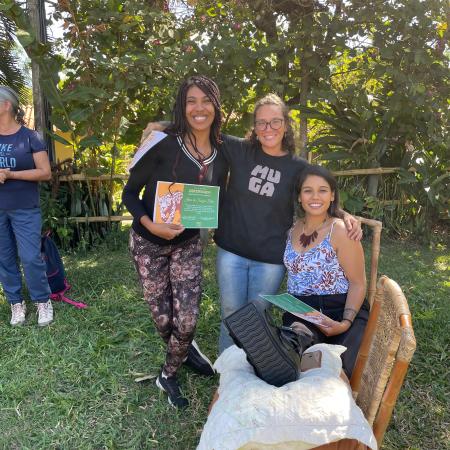
Ívene, an inspiring black woman from Brasília, always dreamed of finding a way to bridge her love for nature with the livelihoods of her community. When she heard about a series of workshops focused on birdwatching and ecotourism aimed at promoting jaguar conservation, she knew she had to be a part of it. The training not only provided her with skills in identifying local bird species but also a deeper understanding of the crucial role that biodiversity plays in maintaining the health of ecosystems.
The workshops emphasized the importance of conserving jaguars as apex predators that help balance the ecosystem and spur tourism activities in rural areas, which can lead to sustainable income. For Ívene, this was more than just a lesson—it was a call to action. Inspired by her new knowledge, she envisioned creating a birdwatching and ecotourism hub in Cocalzinho de Goiás, where she could share the beauty of the region’s wildlife and educate others about conservation.
With the support of the training program, Ívene and her mother began transforming her home into an inviting space for tourists. She set up accommodations, created trails for birdwatching, and developed informational materials highlighting the connection between preserving wildlife and the community. Through her hard work and dedication, Ívene saw an opportunity to conserve nature and empower her community economically.
As tourists started to arrive, both Ívene and her mother's passion and enthusiasm captivated her guests. She shared stories about the birds and jaguars that can be found in the region, the significance of sustainable practices, and the interdependence of humans and nature. Visitors left with a newfound appreciation for the rural beauty of the Cerrado biome. Empowered by her success, Ívene became a symbol of hope for many young women in Cocalzinho, where she began to host workshops for other rural women, to share her knowledge and inspire others to appreciate their natural surroundings.
Today, Ívene's ecotourism initiative continues to thrive. It provides her with an extra income and fosters a sense of pride and connection among the people of her community to the land and the wildlife they protect. She stands as a testament to the power of individual action, reminding us that when we invest in people and their passion for the environment, we can create ripples of change that extend far beyond individual lives, nurturing both nature and communities for generations to come.


